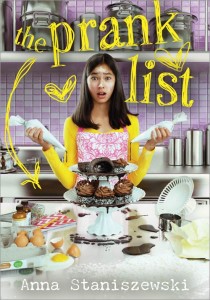Anna Staniszewski is one of my favorite guest bloggers because she always brings such insightful topics and discussions. Today, as she celebrates the upcoming release of her newest book The Prank List (The Dirt Diary #2), Anna is talking the difference between middle grade and young adult fiction. Welcome, Anna!
 What Separates Middle Grade from Young Adult Fiction?
What Separates Middle Grade from Young Adult Fiction?
by Anna Staniszewski
I get this question a lot, so I thought I’d tackle it here. Let’s start with a couple of definitions.
“Middle grade” is generally for ages 7-12, though it can skew a bit younger or older depending on the project (short chapter books vs. longer novels). Middle grade usually features protagonists in elementary or middle school, and if it deals with topics such as sex or violence, those tend to happen off-screen.The ending, while not necessarily happy, should be hopeful.
“Young adult” generally features teen protagonists (14-19) and is often a coming-of-age story for readers 12 and up. (The actual readership of YA varies quite a bit. You might have fifth-graders reading it, but you also have adults who read nothing else.) Issues such as sex and violence can be shown on-screen and can even be of a graphic nature, though you often won’t get as much detail as you would in adult books. Endings, while often hopeful, can sometimes be bleak.
Now that we have that out of the way, we can see that content isn’t necessarily the dividing line between MG and YA. The bigger distinction is how the content is handled, whether it’s off-screen and implied or on-screen and shown.
The protagonist’s age is often a factor, as well, although there is some wiggle room here, too. My main character in The Dirt Diary is 14, for example, but she’s in 8th grade. That puts her right smack in between the two genres, which is why I often refer to the book as “tween,” although it’s generally considered MG.
For me, the biggest difference between MG and YA is the character’s emotional journey. I’ve heard more than one person say that in MG, the character goes through lots of life-changing experiences but can still remain a child at the end. In YA, the character goes through lots of life-changing experiences that force him/her to become an adult. This might be too simplistic of an answer, but I think it goes a long way to explain the difference between the two.
In MG, you have characters exploring their worlds and experiencing what things outside of their own lives are like. In YA, you have characters exploring their own identities and figuring out where they belong in the world. The role of family is different in both; in MG, the family tends to be part of the story, both a support system and a source of conflict, whereas in YA, the family is often secondary or more a source of conflict than anything else. Again, this goes back to the idea of staying a child vs. becoming an adult. At some point, you need to find independence from your family (as many YA protagonists do) and strike out on your own.
Over the past decade or two, the MG and YA markets have changed quite a bit. It used to be that a book with a 14-year-old girl would automatically be labelled as YA, but now that you have more adults reading YA, the genre has started to focus on older and more mature protagonists. That means that MG has expanded too, including a wider range of books, sometimes those that feature younger teens.
Because the market is always shifting, I try not to drive myself too crazy with definitions, but I do try to keep in mind the general attitude in MG vs. YA. That, I think, hasn’t changed too much. In MG, we often still see characters branching out into the world, whereas in YA we see characters who want to find their places in it.
The Prank List blurb:
Rachel Lee never thought she’d fight for the right to clean toilets. But when a rival cleaning business starts stealing her mom’s clients, Rachel will do whatever it takes to save herself the horror of moving to Connecticut—which would mean giving up her almost, sort of boyfriend, her fantastic new pastry classes, and her best friend Marisol.
Operation Save Mom’s Cleaning Business is a go!
But when the series of pranks Rachel and her BFF cook up to take down the competition totally backfires, Rachel worries that her recipe for success is a dud. You know what they say—if you can’t stand the heat, stay out of the kitchen…
Born in Poland and raised in the United States, Anna Staniszewski grew up loving stories in both Polish and English. Currently, she lives outside Boston with her husband and their crazy dog. When she’s not writing, Anna spends her time reading, daydreaming, and challenging unicorns to games of hopscotch. She is the author of the My Very UnFairy Tale Life series and the Dirt Diary series. Her newest book, The Prank List, releases on July 1st from Sourcebooks. You can visit Anna at www.annastan.com.





















Thanks so much for having me!
Happy to have you, Anna! Always a great post when you guest on the blog.
Great, and very insightful post 🙂 This is a topic I often end up discussing with people in my writing group!
Hi, Meradeth! Having been involved in children’s publishing for so long, I often forget that not everyone knows the difference between YA and MG. It’s definitely a great topic to tackle.
Hi Anna and Katie. Anna I really loved your distinction between MG and YA. My book is YA, and the MC is 14 going on 15. I never realized it, but your definition fits my book perfectly for YA. The MC does take a journey and does come out a stronger and wiser person at the end. Though there is no real violence, certain things happen “on screen” that would be difficult for anyone under 10 to understand. That is why it is aged 10 and up. I think the ideal age for reading my book is probably 12, but I think it is a good topic for 5th and 6th graders to discuss too. This is a very thought provoking post.
Anna please contact me, because I would love to have you on my blog too!!!
Thanks so much, Barbara. I’ll be in touch soon!
Hi, Barbara! Glad Anna’s post was so enlightening for you.
Loved this post! It is sometimes hard to express the differences in all of the different categories! As an educator, librarian, and writer, I love having all of this information in one post, that didn’t *just* focus on word-count (as is the way many differentiate the genres!). Thanks so much! I give all MG and YA writers such credit! I have tried, and so far failed, three times to write in these categories. Perhaps it will occur at some point, but for now, I’m sticking to Picture Books! 🙂 Have a great summer everyone!!!
Hi, Kerry! I find focusing only on word count to determine whether something is MG or YA to be frustrating, too. There are so many other factors that go into the distinction. Good luck with all your writing!
Great post, Anna! I’ve written both YA and MG, and still have trouble describing the difference to people. This will help – thanks!
AS someone who writes in both age categories, I found this post very helpful too, Heather!
Great post. Love your work Anna! This new book looks even better than the last (which looked awesome as well)! I hope I get a chance to read it soon.
It’s good to know the definitions of these genres even if you don’t stick to one or the other. I think it’s good for parents to know the difference if they are picking out books for their kids, but it’s also good when things aren’t so defined. It’s sad when an older kid misses out on a great read just because the book is for a younger audience. I love both YA and MG. I can’t even say which one I love more, because they both have great qualities!
Anna’s works is fabulous! I’ve got The Prank List on my TBR list.
Anna does MG voice perfectly. Check her books out, everybody!
She does, Mirka! Voice is so important for MG.
What an interesting article. You make the differences in MG and YA very clear. Some of your points I’ve never thought about. Thanks for sharing.
Your novel sounds like fun and excitement. Congratulations.
Thanks for stopping by, Beverly!
Do you think the label makes a difference to sales, ie an adult might read a YA book but not likely an MG? I like the idea of distinguishing based on the protagonist’s emotional development. That makes sense to me.
Definitely! MG really flies under the radar with a lot of readers. While YA is read by teens and adults, middle grade is generally read by kids (and by teachers, librarians, etc.)
Yes, to what Anna said, Jeff! Personally I find MG to be wonderful, though I do tend to read more YA.
This is a great reminder of what makes these two age categories unique! Looking forward to reading The Prank List. What a great title!
Hi, Andrea! I’m looking forward to reading The Prank List as well. 🙂
Great post, Anna! I love your book covers. They’re all awesome.